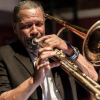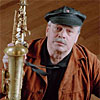Home » Jazz Musicians » Kai Winding
Kai Winding
Trombonist Kai Christen Winding (pronounced ki-win-ding) was one of the founding fathers of be-bop music and truly one of the finest-ever jazz trombonists.
As a sideman to bop’s reigning kings " Fats Navarro, Miles Davis, Charlie Parker, Dizzy Gillespie and Tadd Dameron " he was more a bridesmaid than a bride. Winding recorded too infrequently as a leader during this period and none of his compositions ever really caught on. Indeed, he was adept at putting a defining stamp on others’ compositions " a trait he picked up while outlining the artistry of Stan Kenton’s sound during the mid 1940s.
Kai was born on May 18, 1922, in Aarhaus, Denmark. He came to the United States with his family in 1934. In 1940, he made his professional debut as trombonist with Shorty Allen’s band. He played with the bands of Sonny Dunham and Alvino Rey before joining the U.S. Coast Guard during World War II. After becoming a civilian in 1945, he worked with Benny Goodman’s highly popular band and moved onto Stan Kenton’s orchestra, where he helped defined the brassy Kenton sound and, quickly became a featured soloist. Thereafter, he hooked himself up with a number of emerging stars of be-bop, the “new jazz,” and recorded prolifically " most notably, as part of one of the nonets featured on the historic “The Birth of the Cool” (Capitol/1949).
Winding recorded and performed prolifically during the 1950s, as a leader and " with distinction " behind a number of significant and popular soloists such as Sonny Stitt, Billy Eckstein, Neal Hefti, Woody Herman, Chris Connor, Sylvia Syms.
Still, the trombone was considered an unusual instrument to lead a combo. So it was with prescient oddity that in 1954, producer Ozzie Cadena proposed the marriage of two trombones " Winding’s quick-witted mellifluousness with fellow trombonist J.J. Johnson’s hard-edged angularity. The two leaders clicked together musically right away (check out Savoy “Jay& Kai”) and, surprisingly, became a hugely popular club attraction and critical favorite. Jay and Kai - or “Kai and Jay” or “J.J. & K” or “J & K” or any other of a number of other combinations - was born.
The duo recorded eight highly popular " and consistently artistic " albums over the next two years for the Savoy, RCA, Bethlehem, Prestige and Columbia labels. It was during this period that Kai's great compositional skill was finally recognized with such memorable tunes as "Don't Argue," "Wind Bag," "That's How I Feel About You," "Gong Rock," "Jeanne" and "Caribe."
Read moreTags
Various Artists: The Birth of Bop

by Richard J Salvucci
Someone famously called jazz the sound of surprise, but all too often, what is on offer is the dull hum of routine. Or something like that. This historic reissue is, however, anything but routine. This is not the first time that Teddy Reig's Savoy sides have been reissued (was he also the mysterious Buck Ram listed as producing one track?), but Craft Recordings took a lot of trouble to produce this very fine selection. If a listener were, ...
Continue ReadingMiles Davis: Miles Davis With Tadd Dameron Revisited

by Chris May
1949 was a year of massive change for Miles Davis, and not in a good way. It began, in January, with him fronting the first of the recording sessions, made with a nonet, that became generically known as The Birth Of The Cool and which, if he had achieved nothing else of note, would have secured him a lasting place in jazz history. It ended with him strung out on heroin, a habit that reversed his ascent and which took ...
Continue ReadingVarious Artists: First Impulse: The Creed Taylor Collection 50th Anniversary

by Chris May
The headline news on this lavishly packaged, four-CD collection of the work of the Impulse! label's founding producer, Creed Taylor, is that it includes three previously unreleased tracks by John Coltrane. These were recorded during rehearsals for what would become the saxophonist's Impulse! debut, Africa/Brass, in 1961. They have a combined playing time of less than eight minutes, but as newly discovered Coltrane recordings are reduced to a trickle with the passage of time, the arrival of any such material, ...
Continue ReadingKai Winding: Solo, 1963

Source:
JazzWax by Marc Myers
Trombonist Kai Winding is probably best known to jazz fans for his numerous 1950s albums with trombonist J.J. Johnson. In many regards, Johnson was the memorable player on those LPs with a more singular and inventive style. But Winding also had a spectacular tone and an attack that was crisp, persistent and swinging. His piercing blare was almost trumpet-like. Since we rarely get to hear the Danish-born trombonist by himself in a small group setting to evaluate his gifts, I ...
read more
Jazz Musician of the Day: Kai Winding

Source:
Michael Ricci
All About Jazz is celebrating Kai Winding's birthday today!
Trombonist Kai Christen Winding (pronounced ki-win-ding) was one of the founding fathers of be-bop music and truly one of the finest-ever jazz trombonists. As a sideman to bop’s reigning kings “ Fats Navarro, Miles Davis, Charlie Parker, Dizzy Gillespie and Tadd Dameron “ he was more a bridesmaid than a bride. Winding recorded too infrequently as a leader during this period and none of his compositions ever really caught on. Indeed, ...
read more
Jazz Musician of the Day: Kai Winding

Source:
Michael Ricci
All About Jazz is celebrating Kai Winding's birthday today!
Trombonist Kai Christen Winding (pronounced ki-win-ding) was one of the founding fathers of be-bop music and truly one of the finest-ever jazz trombonists. As a sideman to bop’s reigning kings “ Fats Navarro, Miles Davis, Charlie Parker, Dizzy Gillespie and Tadd Dameron “ he was more a bridesmaid than a bride. Winding recorded too infrequently as a leader during this period and none of his compositions ever really caught on. Indeed, ...
read more
Jazz Musician of the Day: Kai Winding

Source:
Michael Ricci
All About Jazz is celebrating Kai Winding's birthday today!
Trombonist Kai Christen Winding (pronounced ki-win-ding) was one of the founding fathers of be-bop music and truly one of the finest-ever jazz trombonists. As a sideman to bop’s reigning kings “ Fats Navarro, Miles Davis, Charlie Parker, Dizzy Gillespie and Tadd Dameron “ he was more a bridesmaid than a bride. Winding recorded too infrequently as a leader during this period and none of his compositions ever really caught on. Indeed, ...
read more
Jazz Musician of the Day: Kai Winding

Source:
Michael Ricci
All About Jazz is celebrating Kai Winding's birthday today!
Trombonist Kai Christen Winding (pronounced ki-win-ding) was one of the founding fathers of be-bop music and truly one of the finest-ever jazz trombonists. As a sideman to bop’s reigning kings “ Fats Navarro, Miles Davis, Charlie Parker, Dizzy Gillespie and Tadd Dameron “ he was more a bridesmaid than a bride. Winding recorded too infrequently as a leader during this period and none of his compositions ever really caught on. Indeed, ...
read more
Jazz Musician of the Day: Kai Winding

Source:
Michael Ricci
All About Jazz is celebrating Kai Winding's birthday today!
Trombonist Kai Christen Winding (pronounced ki-win-ding) was one of the founding fathers of be-bop music and truly one of the finest-ever jazz trombonists. As a sideman to bop’s reigning kings “ Fats Navarro, Miles Davis, Charlie Parker, Dizzy Gillespie and Tadd Dameron “ he was more a bridesmaid than a bride. Winding recorded too infrequently as a leader during this period and none of his compositions ever really caught on. Indeed... ...
read more
Jazz Musician of the Day: Kai Winding

Source:
Michael Ricci
All About Jazz is celebrating Kai Winding's birthday today!
Trombonist Kai Christen Winding (pronounced ki-win-ding) was one of the founding fathers of be-bop music and truly one of the finest-ever jazz trombonists. As a sideman to bop’s reigning kings “ Fats Navarro, Miles Davis, Charlie Parker, Dizzy Gillespie and Tadd Dameron “ he was more a bridesmaid than a bride. Winding recorded too infrequently as a leader during this period and none of his compositions ever really caught on. Indeed... ...
read more
Jay & Kai Plus 6: 1956

Source:
JazzWax by Marc Myers
Since we're on the subject this week of multiple instruments of the same stripe working together, let's dig one of the best albums of trombones— Jay & Kay + 6, produced by George Avakian over three dates in April 1956 for the Columbia label. It's almost frightening to write down who's on this octet album. In the trombone chairs: J.J. Johnson, Kai Winding, Bob Alexander, Eddie Bert, Urbie Green, Jimmy Cleveland (tb) Tom Mitchell and Bart Varsalona (b-tb). The rhythm section: ...
read more






































